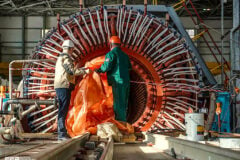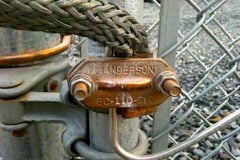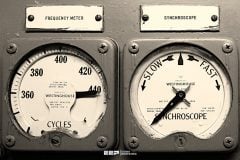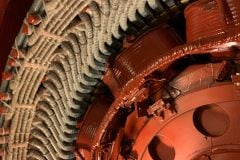Generator Unit Protection
This technical article gives key points about the generator protection. To recover the generator from various kinds of faults, the generator protection scheme of the plant must be designed in such a way that groupings of protection are made respect to the plant’s need.

As it was 100 years ago, generator is still the heart of an electrical power system. The prime mover which drives the generator provides the necessary input mechanical energy for conversion into electrical energy by the generator.
The prime mover can be based on steam, gas, water power and diesel engines, and so on.
Let’s focus now on key points of protection:
- Generator Unit Protection
- Classification Of Tripping
- Grouping Of Protections In Class Al, A2, B and C Tripping
- Protection Philosophy
- Less Severe Fault Conditions
- Trends In Generator Protection
1. Generator Unit Protection
The generator’s ratings may vary from a few hundred kVA to as much as 500 MVA or more. The present largest installed single generator unit in India has a capacity as large as 500 MW. Future projects with unit capacities as large as 660 MW are being envisaged in the country.
While the smaller generating sets may be directly connected to the distribution system, larger units are usually associated with generator transformers for connection to EHV transmission systems.
The power for the auxiliaries is also drawn from the large generating units via auxiliary transformers.
Figure 1 represents a typical single line diagram (SLD) representation of the unit. The failure rate in generators is low due to modern design practices and improved technology. However, the rare occurrences of failure may result in severe damage and long shutdowns for repairs. Hence the abnormal conditions must be recognized promptly to quickly isolate the system.
In order to achieve maximum utilization of installed generator capacity, the unit protection should be designed in such a way that the damage caused by faults is kept to a minimum.


Some of the faults do not require the unit to be tripped automatically since in a properly attended station, they can be corrected while the machine remains in service. These conditions are sig-nalled by alarms. However, certain faults require prompt isolation of the machine.
These are:
- Faults in stator winding
- Faults in rotor winding
- Faults in transformer winding
- Overload
- Over-heating of windings/bearings
- Over-speed
- Loss of excitation
- Motoring
- Inadvertent energization
- Single-phase or unbalanced current operation and
- Out of step.
2. Classification Of Tripping
The classification of tripping is categorized on the basis of the location and type of faults. The classes of tripping are different from one another in respect to the action to be taken
There are normally three types of classes of tripping, namely Class A, Class B and Class C.
2.1 Class ‘A’ Tripping
In this tripping mode, the generator and turbine will be tripped simultaneously and instantly. Generally, electrical faults of the generator, generator transformer and unit auxiliary transformer will lead to Class A tripping.
This will cause tripping of the generator transformer HV side circuit breaker, de-excitation of the generator, tripping of LV side incomer breaker of unit auxiliary transformer, auto-changeover from unit to station supply for unit auxiliaries and tripping of turbine.
For large generators (500 MW and above), Class A tripping is further sub-divided into Class Al and Class A2 with class A2 excluding the generator transformer HVCB tripping and unit transformer LVCB tripping.
However, Class A2 tripping takes place only when there is a generator circuit breaker.


The auxiliaries are fed through unit transformer by back charging of GT. Thus in Class A2 trip we are able to maintain uninterrupted power to the Unit bus and auxiliaries which was not possible in the scheme without generator circuit breaker.
2.2 Class ‘B’ Tripping
Class B tripping is followed for all turbine faults which are mechanical in nature and for some electrical faults of generator, generator transformer and unit auxiliary transformer for which it is safe to first trip the turbine and then the generator through low forward power interlock.
2.3 Class ‘C’ Tripping
This class of tripping is followed for all faults beyond the generator system which can be cleared by tripping of the generator transformer HV side circuit breaker alone.
In case of a thermal unit, the TG set runs with an HP/LP bypass system in operation and the generator continues to feed the unit auxiliary transformer.
3. Grouping Of Protections In Class Al, A2, B and C Tripping
For a typical 500 MW generator, the recommended grouping of protections in various tripping classes is discussed in detail below.
3.1 Class ‘Al’ Tripping
Class A1 tripping include the following protections:
- Generator back-up impedance protection
- Generator dead machine accidental energization protection
- Generator earth fault protection
- Generator transformer pressure relief valve protection
- Generator transformer sudden pressure valve protection
- Generator transformer Buchholz relay trip protection
- Fire protection of the generator transformer
- Generator transformer standby earth fault protection
- Differential protection for generator transformer HV side to overhead transmission line link
- Generator transformer differential protection
- Differential protection covering the generator transformer and overhead connections to the unit auxiliary transformer
- Generator breaker fail protection
- Generator transformer over-fluxing protection
- Unit transformer Buchholz protection
- Unit transformer oil surge protection
- Unit transformer pressure high protection
- Unit transformer HV over-current protection
- Unit transformer LV earth fault protection
- Unit transformer differential protection
- Unit transformer restricted earth fault protection
- Unit transformer fire protection
- Tee differential protection
- Generator transformer HV circuit breaker pole discrepancy protection and
- Generator transformer HV circuit breaker fail protection.
3.2 Class ‘A2’Tripping
Class A2 tripping include the following protections:
- Generator field failure protection (delayed tripping)
- Generator field failure in conjunction with generator under-voltage protection (instantaneous tripping)
- Generator negative phase sequence protection
- Generator over-voltage protection stage 2
- Generator 90 per cent stator earth fault protection
- Generator inter-turn fault protection
- Generator 100 per cent stator earth fault protection
- Generator rotor earth fault protection
- Generator differential protection
- Generator low forward power protection (tripping after a sufficient time delay, allowing for Class B tripping first)
- Generator out-of-step (pole slipping) protection in conjunction with static offset mho relay operated condition and
- Generator over-fluxing protection.
3.3 Class ‘B’ Tripping
Class B tripping include the following protections:
- Generator low forward power protection after a short time delay
- Turbine faults
- Generator winding temperature high
- Generator bearing temperature high and
- Turbine bearing temperature high.
3.4 Class ‘C’ Tripping
Class C tripping include the following protections:
- Generator under frequency protection stage 2 (stage 1 is for alarming).
In case of hydro units, the following faults are also covered in this Class C tripping (also called Class Z tripping):
- Reverse power fault
- Over-fluxing fault and
- Negative phase sequence fault.
4. Protection Philosophy
For increased reliability, some vital protections are duplicated. However, since many protective relays either back-up or overlap, it is not necessary to duplicate all the protections.
Higher reliability can be achieved by dividing the protective relays into two groups, with each group catering to the basic minimum protection of the unit.
The typical groupings of protections for a large unit (500 MW) are given Table 1 in next section.
However, during maintenance, etc., the unit can still be in service with only one of the protective groups in operation.
Typical groupings of protections for a large unit (500 MW) are delineated in Table 1 below.
Table 1 – Typical Groupings of Protections for a Large Unit
| Protection | Group 1 | Group 2 |
| Generator dead machine | ✓ | — |
| Generator transformer internal pressure high | ✓ | — |
| Generator transformer sudden increase in internal pressure | — | ✓ |
| Generator transformer Buchholz relay trip | — | ✓ |
| Fire protection of generator transformer | ✓ | — |
| Standby earth fault protection of Generator transformer | — | ✓ |
| Differential protection of generator transformer to HV side OH line link | ✓ | — |
| Differential protection of generator transformer | — | ✓ |
| Differential protection covering generator transformer and unit auxiliary transformer | ✓ | — |
| Generator breaker fail protection | ✓ | — |
| Generator transformer over-fluxing protection | — | ✓ |
| Unit transformer Buchholz protection | ✓ | — |
| Unit transformer internal pressure high protection | — | ✓ |
| Unit transformer HV over-current protection | — | ✓ |
| Unit transformer differential protection | ✓ | — |
| Unit transformer restricted earth fault protection | — | ✓ |
| Unit transformer fire protection | — | ✓ |
| Tee differential protection | ✓ | ✓ |
| Generator transformer HV circuit breaker pole discrepancy protection | ✓ | — |
| Generator transformer HV circuit breaker fail protection | — | ✓ |
| Generator field failure protection | ✓ | ✓ |
| Generator negative phase sequence protection | — | ✓ |
| Generator over-voltage protection | ✓ | ✓ |
| Generator stator E/F protection (90%) | ✓ | — |
| Generator inter-turn fault protection | ✓ | — |
| Generator rotor earth fault protection | — | ✓ |
| Generator 100 per cent stator earth fault protection | — | ✓ |
| Generator differential protection | ✓ | ✓ |
| Generator low forward power protection | ✓ | ✓ |
| Generator pole slipping protection | ✓ | — |
| Generator over-fluxing protection | ✓ | — |
| Generator under frequency stage 2 | ✓ | ✓ |
5. Less Severe Fault Conditions
There are some faults, however, which do not require isolation of the unit and are to be signaled by alarms so that necessary corrective action may be taken with the unit in running condition.
A typical list of such faults for a large unit may include the following. Note that these faults are signaled as alarms on the digital distributed control and monitoring information system:
- Generator negative phase sequence stage 1
- Generator over-voltage stage 1
- Generator voltage transformer fuse failed
- Generator integrated protection relay faulty
- Generator protection group 1 or protection group 2 DC supply failed
- Generator transformer oil level low
- Generator transformer oil temperature moderately high
- Generator transformer winding temperature moderately high
- Generator transformer normal cooler failure
- Generator transformer normal cooler oil flow low condition
- Generator transformer Buchholz relay alarm (stage 1) condition
- Generator transformer over-fluxing condition
- Disturbance recorder operated condition
- Unit transformer on-load tap changer (OLTC) control supply failure
- Unit transformer bank fan failure
- Unit transformer OLTC mechanism stuck-up
- Unit transformer OLTC drive motor auto-trip
- Generator CB trip circuit supervision relay operated and
- Tripping relays’ coil circuit interrupted (indicated by the coil supervision relay)
6. Trends In Generator Protection
In latest power stations, the state-of-the-art integrated control and protection system is installed. The relay is multi-functional with a communication facility and is integrated with a digital distributed control and monitoring information system.
It also maximizes protection availability through extensive self-monitoring and system supervision.
References //
- Switchgears book by BHEL – Bharat Heavy Electricals Limited
- An Overview of Classes and Grouping in Generator Protection at V.I.P.L. (Nagpur) by Prof. V. R. Doifode, Manali V.Aranke, Suyash M.Choudhary, Vividha V.Dhengre and Anmol M.Thawkar











Outstanding Technical Explanation. Keep it up, this article is really helpful and interesting from generator protection point of view. Thanks for sharing!
Thank Very informative and detailed to well presented.
A question though, for example if I were to get a system whereby the generator rating is given say (1500MVA, 13kV), THE generator connected via busbar to the step up main transformer and auxiliaries transformer.
Assumptions:
step up MAIN transformer TO BE STEPPED UP TO 120kV
ner=8ohms
how would you go about calculation settings(CT’S RATIO) FOR PRIMARY AND SECOBDARY ?
Very well presented article, thank you.
Thanks .
Best Resumed Technical Article about generator protection on the Web.
Regards
Thank you for every time
Excellent article….classification of trippings is required to know the real problem in generator
Why not assign the out-of-step function into the class C?
Agreed, Generator circuit-breaker are the best way to increase the selectivity & protection of any power plants. If I´m not mistaken, according the IEC/IEEE 62271-37-013 I do believe that GCB are a must from 50MVA and above, isn´t it ?
I don’t think that a IEC/IEEE std. will ever mandate a component, it applies for GCB above 10MVA but you can easily interrupt the DC component of a S/C at generator terminals with a MVSWG incomer up to 80-90MVA of rotating equipment rated power. Above it will be unpractical and hence a standalone GCB is a must
Excellent Technical Article will certainly be keeping an eye out for future articles